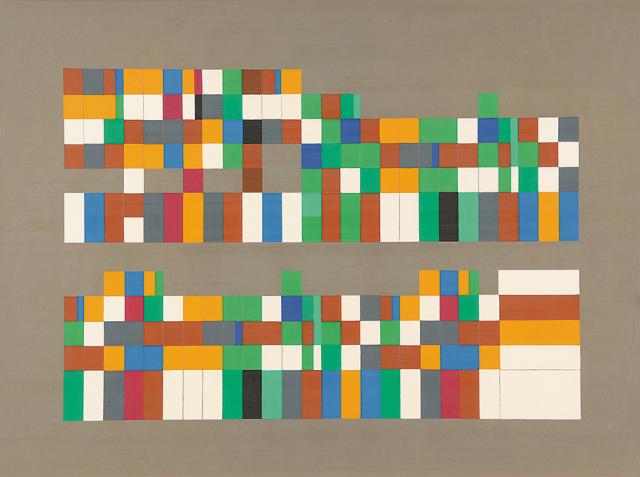Self-taught musician and artist Robert Strübin, born in Basel in 1897, grew up in a family in which art and music played a dominant role. Trained as a pianist, he turned to drawing in 1932, then to painting a few years later. His first graphic works were architectural structures made up of geometric shapes, and these were gradually replaced by rosette compositions in the 1940s.
In 1956, Strübin abandoned piano-playing for health reasons and undertook a more personal and singular pictorial approach: musical images. He based each work on a specific piece of music (after which it was named), transferring the score in coloured rectangles that reflected the height and length of the notes. This method was founded on the phenomenon of coloured hearing or photism, that is to say the subjective association of sounds through colour values.
Three compositions created through this system of musical notation are found in the Pictet Collection: Komposition nach Rudolf Kelterborn (1961), Komposition nach H. W. Henze (undated) and Fr. Chopin. Prélude Nr. 20/do min. (1962). With the help of colour palettes carefully defined by the artist, one colour being attributed to each note, he fills the surface of the paper in a linear way. The conversion system varies from one image to another, as does the rhythm of the piece that is given through the form and spacing of the coloured zones.
From the very spaced-out compositions to the densest ones, Strübin’s avant-gardist practice does not seek abstraction, but rather aims to objectify music outside of any notion of time and emotion. Among others, this method is reminiscent of that of concrete art, which was based on mathematics, its manifesto (1930) stipulating that: “Concrete art is not an abstraction. […] Concrete art is not narrative, literary. It is similar to music.”
Strübin’s work has remained on the margins, and its limited reception only started belatedly. His first solo exhibition took place in 1964 in Basel, but it was after his death in 1970 that a retrospective was dedicated to his work at the Kunstmuseum Lucerne, on the initiative Jean-Christophe Ammann. In 1972, Harald Szeemann included five of Strübin’s musical images in documenta 5, which he directed, and presented his work again in the exhibition Visionäre Schweiz (1991-1992) at the Kunsthaus Zurich.
In 1956, Strübin abandoned piano-playing for health reasons and undertook a more personal and singular pictorial approach: musical images. He based each work on a specific piece of music (after which it was named), transferring the score in coloured rectangles that reflected the height and length of the notes. This method was founded on the phenomenon of coloured hearing or photism, that is to say the subjective association of sounds through colour values.
Three compositions created through this system of musical notation are found in the Pictet Collection: Komposition nach Rudolf Kelterborn (1961), Komposition nach H. W. Henze (undated) and Fr. Chopin. Prélude Nr. 20/do min. (1962). With the help of colour palettes carefully defined by the artist, one colour being attributed to each note, he fills the surface of the paper in a linear way. The conversion system varies from one image to another, as does the rhythm of the piece that is given through the form and spacing of the coloured zones.
From the very spaced-out compositions to the densest ones, Strübin’s avant-gardist practice does not seek abstraction, but rather aims to objectify music outside of any notion of time and emotion. Among others, this method is reminiscent of that of concrete art, which was based on mathematics, its manifesto (1930) stipulating that: “Concrete art is not an abstraction. […] Concrete art is not narrative, literary. It is similar to music.”
Strübin’s work has remained on the margins, and its limited reception only started belatedly. His first solo exhibition took place in 1964 in Basel, but it was after his death in 1970 that a retrospective was dedicated to his work at the Kunstmuseum Lucerne, on the initiative Jean-Christophe Ammann. In 1972, Harald Szeemann included five of Strübin’s musical images in documenta 5, which he directed, and presented his work again in the exhibition Visionäre Schweiz (1991-1992) at the Kunsthaus Zurich.
